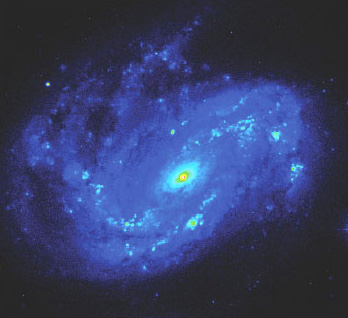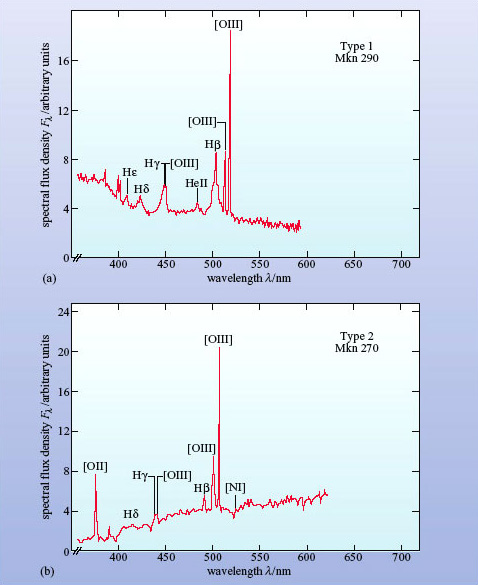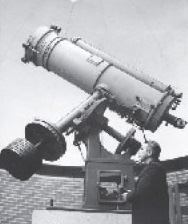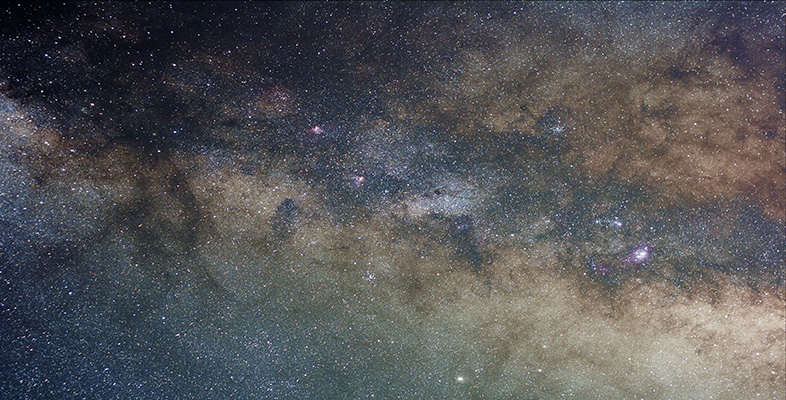3.2 Seyfert galaxies
In 1943 the American astronomer Carl Seyfert (1911-1960) drew attention to a handful of spiral galaxies that had unusually bright point-like nuclei. Figure 12 shows NGC 4051, one of the first Seyfert galaxies to be identified. Subsequently, it has been found that compared to normal galaxies, Seyfert galaxies show an excess of radiation in the far infrared and at other wavelengths. Even more remarkably, at some wavelengths, including the optical, this excess radiation is variable. The variability implies that the emission from a Seyfert galaxy must come from a region that is tiny compared to the galaxy itself.

Spectra of the bright nuclei reveal that Seyferts can be classified into two types by the relative widths of their emission lines (Figure 13).

Type 1 Seyferts have two sets of emission lines (Figure 13a). The narrower set, which are made up largely of the forbidden lines discussed earlier, have widths of about 400 km s−1. Despite this considerable width the region emitting these lines is known as the narrow-line region. The broader lines, consisting of permitted lines only, have widths up to 10 000 km s−1 and appear to originate from a denser region of gas known as the broad-line region.
Forbidden lines are sensitive to the gas density in the emitting region. An analysis of which lines are present allows the densities of the gas in the broad- and narrow-line regions to be determined. These two regions are also characteristic of other types of active galaxy. Type 2 Seyferts only show prominent narrow lines (Figure 13b). The broad lines are either absent or very weak in the optical spectra of type 2 Seyferts.
In fact, these two types are not as clear cut as they first seemed, since weak broad lines have now been found in Seyferts previously classed as type 2. Types 1 and 2 are better understood as extreme ends of a range of intermediate Seyfert types classified according to the relative strengths of their broad and narrow lines. In a Seyfert 1.5, for example, there are broad and narrow lines, but the broad lines are not as strong as those seen in type 1 Seyferts.
Box 3: Carl Keenan Seyfert (1911-1960)

Carl Seyfert (Figure 14) was born and grew up in Cleveland, Ohio. He entered Harvard with the intention of studying medicine, but became diverted from this career path after attending an inspirational lecture course in astronomy given by Bart Bok. Seyfert switched his attention to astronomy and remained at Harvard to carry out his doctoral research under the direction of Harlow Shapley.
Following a post at Yerkes Observatory he was employed at Mount Wilson Observatory from 1940 to 1942. It was during this time at Mount Wilson that he carried out his observations into the type of galaxies that now carry his name. During the Second World War he managed to juggle several tasks: teaching navigation to the armed forces, carrying out classified research, and still finding time to partake in some astronomical research. He is notable for producing some of the first colour photographs of nebulae and stellar spectra - some of which were used in the Encyclopedia Britannica.
After the war Seyfert gained a faculty position at Vanderbilt University in Nashville, Tennessee. He was the driving force behind the development of their observatory and was also an enthusiastic popularizer of science. He also found time to present local weather forecasts on television! He was tragically killed in a motor accident in 1960 at the age of 49. He died before the significance of Seyfert galaxies became fully apparent - the field of active galaxy research only became a key area of astronomy after the discovery of quasars in 1963.
